STEEM Course: IPv4 Routing Primer (Part 3)
Hello and welcome! I am currently working on a video course regarding Routing for IP version 4, and I've decided to post my slides and scripts here on STEEM as I go along. I appreciate any feedback or suggestions, or if you are new to the world of computer networking, I hope you enjoy them! If you are brand new to the topic, I recommend that you review my previous course posted on STEEM titled IP Version 4 Addressing And Subnetting Deep Dive.
Here is part 3 of a multi-part series. In this section, we will describe the operation of both the routing and forwarding tables. How many parts will there be? I have no idea because I am posting them as I go along. This and all @steempeak initiated posts will have a 4% beneficiary set to @null to help fight inflation.
If you missed any sections, click one of the links below for your favorite front end:
PART 1:
https://steempeak.com/stem/@joshman/steem-course-ipv4-routing-primer-part-1
https://busy.org/@joshman/steem-course-ipv4-routing-primer-part-1
https://steemit.com/stem/@joshman/steem-course-ipv4-routing-primer-part-1
PART 2:
https://steempeak.com/stem/@joshman/steem-course-ipv4-routing-primer-part-2
https://busy.org/@joshman/steem-course-ipv4-routing-primer-part-2
https://steemit.com/stem/@joshman/steem-course-ipv4-routing-primer-part-2
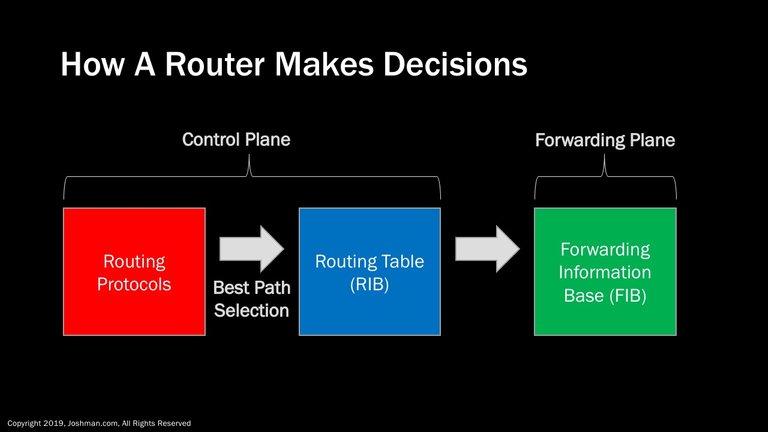
Each routing protocol will choose its best route via a best path selection criteria. Static routes are also compared here.
The best route from that protocol will be compared to routes from other protocols, then be placed into the routing table.
The routing protocols themselves along with the routing table are said to exist within the control plane of the device. The control plane is the conceptual function of a router that determines the network topology.
Once the routing table is built, the information is used to populate the Forwarding Information Base (FIB). The forwarding information base is said to exist within the forwarding plane of the device. The forwarding plane is the conceptual function of a router which is responsible for actually forwarding packets to their destination.
Let’s take a look at each of these steps in more detail.
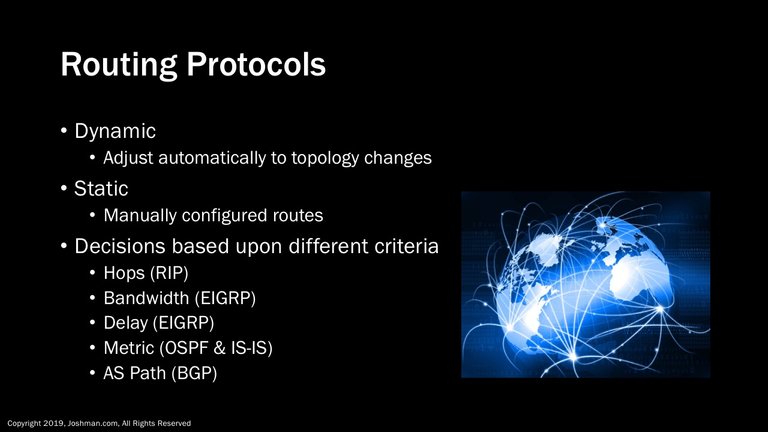
For the routing decision making process, we can populate the routing table through dynamic or static means. Dynamic routing protocols can adjust the routing table automatically as the network topology changes. Static routing is the process of manually configuring a route on a single router.
Within routing protocols, decisions are made to find the best route by using a number of different criteria.
For example:
- RIP uses the number of network hops or routers
- EIGRP uses metrics such as bandwidth and delay
- OSPF and IS-IS uses a metric
- BGP utilizes an AS Path, which is the number of Autonomous systems you must pass through to reach the destination.
We will discuss these protocols in more detail later on.
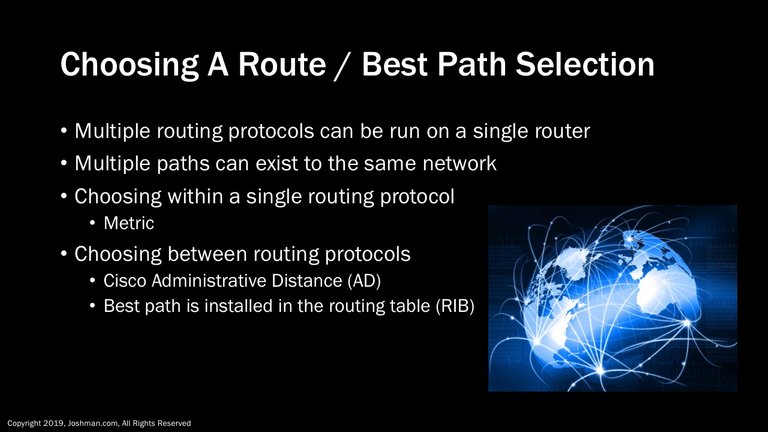
A router can run more than one router protocol simultaneously. Because of this, multiple paths can exist to the same network destination.
A routing protocol must have a mechanism to choose between identical routes received from different neighbors, this is referred to as a metric.
A router must also have a mechanism to choose between identical routes received from multiple routing protocols. For cisco routers, this mechanism is known as Administrative Distance (AD).
The routing protocol’s route with the lowest AD will be installed into the routing table.

Administrative Distance (AD) was developed by Cisco, to help a router determine which routes to install into the routing table.
The table consists of some examples of the more popular default administrative distances. Other vendors use the same concept, but the values or names may be different.
For administrative distance, lower values are better. The absolute best AD is that of a connected interface’s route. This makes sense, because this is the route of a network directly connected to the router. The absolute worst is an unknown route. An unknown route will never be installed into the routing table.
The administrative distances of routes can be manipulated to make a route or set of routes more preferred. For example, I can create a static route as a backup to an EIGRP route, by setting the administrative distance of the static route higher than the AD of EIGRP, which is 90.
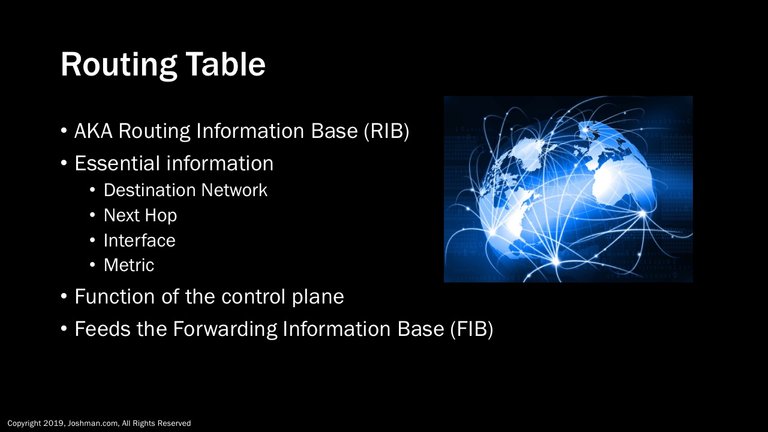
Now that we have a better idea of how the routing table, also called a Routing Information Base (RIB) gets fed information, let’s take a look at the routing table itself.
All routing tables must contain the following information:
- Destination network – this is the network being advertised
- Next hop – this is the next router in the path to the destination
- Interface – the interface through which the next hop is reachable
- Metric – this can include the metric of the routing protocol as well as the administrative distance
After the routing table is constructed, it will then feed the forwarding information base (FIB)
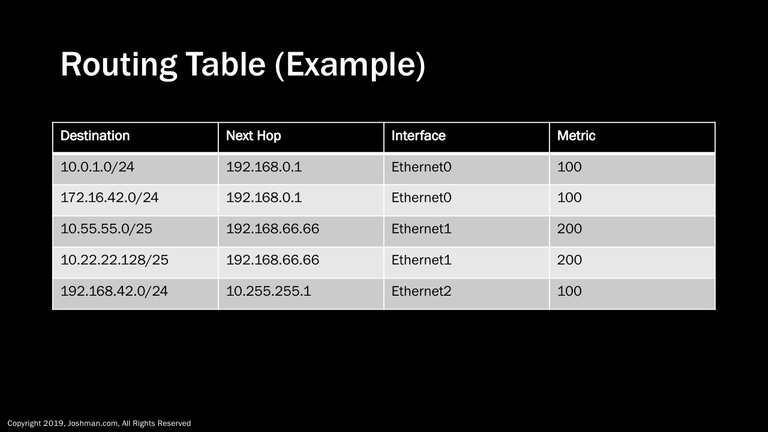
Here is an example of a simple routing table on a router with three Ethernet interfaces. There are two destinations available via the next hop router attached via Ethernet0, two destinations via Ethernet1, and one destination via Ethernet2.
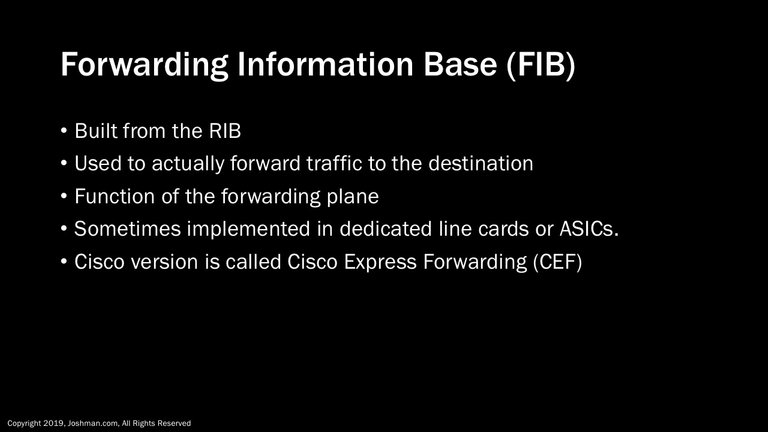
Once the routing table or routing information base (RIB) is built, it can be used to populate the forwarding information base (FIB). The fib is where the rubber meets the road in terms of actually forwarding traffic based upon the information contained within the routing table. It is part of the forwarding plane. Depending on the device, the forwarding information base can be implemented in a number of ways including in dedicated hardware such as line cards or ASICs. For high performance Cisco devices it is referred to as Cisco Express Forwarding (CEF).
Thanks for viewing! In the next part, we will describe routing concepts like longest match and split horizon.
This has some great info! thanks
Posted using Partiko Android
You're welcome!
Just want you to know that I have these bookmarked for future reference.
Never know I might need them.
Aw shucks
This post has been voted on by the SteemSTEM curation team and voting trail. It is elligible for support from @curie.
If you appreciate the work we are doing, then consider supporting our witness stem.witness. Additional witness support to the curie witness would be appreciated as well.
For additional information please join us on the SteemSTEM discord and to get to know the rest of the community!
Thanks for having added @steemstem as a beneficiary to your post. This granted you a stronger support from SteemSTEM.
Please consider using the steemstem.io app to get a stronger support.